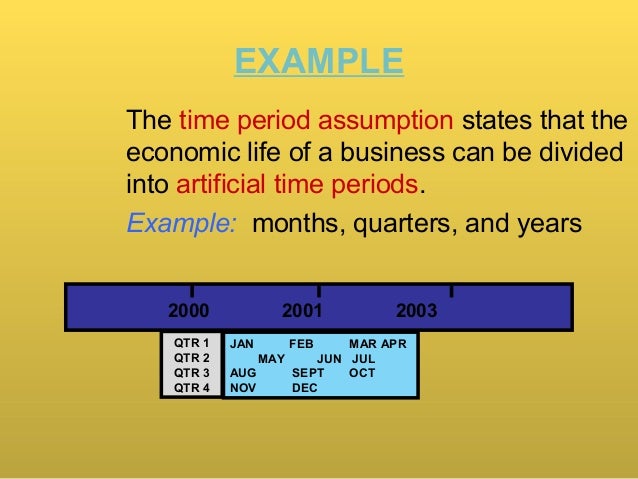
The Realization Principle is a cornerstone of accrual accounting, providing a framework for recognizing revenue in a company’s financial statements. It dictates that revenue should only be recognized when it is earned and realizable, regardless of when cash is received. – The matching concept and revenue recognition principle also contribute to the periodicity assumption. Both of these accounting principles allow businesses to allocated expenses and record revenues for specific periods of time.
Why Do Companies Use Time Period Assumptions?
It enables the analyst to observe performance over consistent intervals, making it easier to spot anomalies, trends, and patterns. The time period assumption is a fundamental concept in accounting that allows businesses to divide their complex financial activities into shorter, more manageable intervals, typically months, quarters, or years. This division facilitates the timely reporting of financial performance and position to stakeholders. However, applying this assumption is not without its challenges, which can significantly impact the accuracy and relevance of financial statements. This assumption is crucial for providing timely and relevant financial information to stakeholders. However, applying this assumption is not without its challenges and considerations, which can significantly impact the interpretation and comparability of financial statements.
- For example, you would express the cost of a purchase in dollars, rather than units of time or amount of effort.
- My Accounting Course is a world-class educational resource developed by experts to simplify accounting, finance, & investment analysis topics, so students and professionals can learn and propel their careers.
- Normally, an accounting period consists of a quarter, six months or a year depending on the needs of business entity and its stakeholders.
- Business leaders and managers are also reconsidering the time period assumption in light of the demand for more timely and relevant financial information.
- It’s also possible that these assumptions can make it difficult for readers who are unfamiliar with how they work in financial statements.
Time Period Assumption vsOther Accounting Principles

This approach not only adheres to the time period assumption but also provides a more accurate representation of the company’s earnings throughout the year. Regulatory bodies enforce the Realization Principle to maintain consistency and comparability across financial statements. This uniform application aids in preventing the manipulation of revenue recognition, which could lead to misleading financial reporting and potentially fraudulent activities.
Legal and Regulatory Implications of Time Period Assumption
11 Financial’s website is limited to the dissemination of general information pertaining to its advisory services, together with access to additional investment-related information, publications, and links.
It provides a comprehensive set of rules that govern the entire spectrum of financial transactions, ensuring that financial statements are a reliable source of information for all users. The intersection of time and revenue recognition is a dynamic space where accounting theory meets practical application. It requires a nuanced understanding of both the temporal constraints imposed by the time period assumption and the broader economic realities that shape revenue generation. By navigating this intersection with care, businesses can ensure that their financial reporting remains transparent, accurate, and reflective of their true economic performance. From the perspective of an accountant, the Time Period Assumption is essential for preparing accurate and timely financial reports.
From a manager’s point of view, this synthesis aids in performance evaluation and decision-making. Managers rely on periodic financial statements to assess the company’s performance and make informed decisions. They need to understand the implications of these accounting principles to interpret the financial statements correctly.
For example, consider a company that signs a contract in December to provide services over the next six months. According to the time period assumption, the company would recognize revenue each month as the service is provided, not just when the contract is signed or when payment is received. This method ensures that the revenue is matched with the period in which the service was actually performed, providing a clearer picture of the company’s financial activities during that time. The time period assumption is a fundamental principle in accounting, stipulating that the life of a business can be divided into artificial time periods to provide timely information to users. However, the future of reporting is being shaped by several trends that challenge this assumption, necessitating a reevaluation of reporting frequency and methods.
Periodicity also allows the manufacturer to report the revenues and net income it earned in each of the months during the two-year contract. All related parties need to know company performance and financial position to make proper decisions. A one-year period that companies use for financial reporting and budgeting, which may or may not align turbotax deluxe 2011 federal and state returns, pc windows with the calendar year. Readers can see that there is $100 million in total revenue, but they don’t know much about how it was earned or what months were particularly strong or weak. Quantifiability means that records should be stated in terms of money, usually in the currency of the country where the financial statements are prepared.
A fiscal year is a 12-month period ending in any day throughout the year, for example, April 1 to March 31 of the following year. Ms. B owns a cleaning services business and another business which is a chemical manufacturer. The chemical manufacturing company supplies detergent and other cleaning chemicals to the cleaning services company. Mr. A opens a laundromat business by investing $50,000 and 10 sets of commercial washers and dryers under the registered name of the business, LaundrySpree. He also has $10,000 remaining in his personal bank account and an unpaid personal loan amounting to $500. For instance, in the United States, many companies operate on an October 1st to September 30th fiscal year to align with the federal government’s fiscal year.